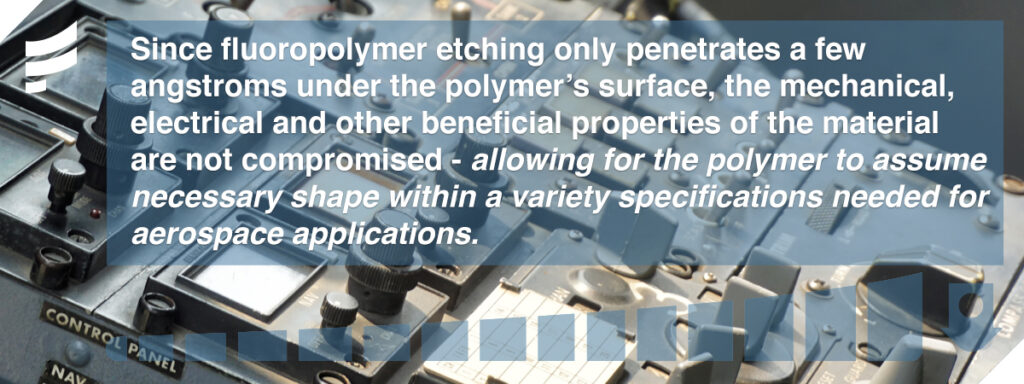
A fluoropolymer is a polymer (plastic) that consists of carbon and fluorine bonds. These environmental conditions include, but are not limited to, ones of highly reactive chemical volatility, exposure to extreme temperatures, degradation caused by weathering and the introduction of radiation to systems. In the aerospace industry, fluoropolymers can appear in the form of coatings for electronic systems and batteries, custom liners for aircraft interiors, custom tubing for cable and wire insulation and more.
Fluoropolymers are often split into two distinct classes: fully fluorinated polymers and partially fluorinated polymers. Examples of fully fluorinated polymers include Polytetrafluoroethylene (PTFE), Fluorinated Ethylene Propylene Copolymer (FEP), and Perfluoroalkoxy Polymer (PFA), while partially fluorinated polymers include Polyvinylidene Fluoride (PVDF), and Ethylene Chlorotrifluoroethylene Copolymer (ECTFE). Compared to their counterparts, fully fluorinated polymers offer higher thermal and chemical resistances but sacrifice mechanical properties such as tensile strength and resistance to cutting. The opposite tradeoff is true for partially fluorinated polymers.

Types of Fluoropolymers
Of the aforementioned classes of polymers, fully fluorinated polymers PTFE, FEP, and PFA are the most commonly used. PTFE’s mechanical properties include having a high melting point of 327 degrees Celsius (620ºF)- which allows for continuous use at 260 degrees Celsius (500ºF). It is insoluble in all solvents and thus chemically inert under normal usage conditions as well as equipped with a low coefficient of friction.
Due to its chemical makeup, PTFE also exhibits superior quality electrical properties, such as a low dielectric constant of 2.0 and a high insulation resistance. The combined value add of these qualities positions PTFE as the ideal material for aerospace tubing – in mission critical applications, PTFE wire harnessing extends the durability of electronic systems by preserving signal integrity of data in high radiation and electrically conductive environments.
This logic follows for fuel lines made of PTFE. The chemical inertness of PTFE allows for high resistance to corrosion introduced by engine fuel, oil, and other highly reactive substances present in aerospace applications.As a result, this allows for longer project lifecycles, higher usability of parts, and drives down cost within the aerospace manufacturing ecosystem.
Finally, PTFE offers protection from volatile external weather environments, such as exposure to previously mentioned high temperature liquids like fuel, and low temperature conditions present in the upper atmosphere and space. Like PTFE, FEP and PFA exhibit similar qualities of high chemical resistance, protection against temperature volatility, and ability to be custom formed for respective aerospace applications. The respective chemical characteristics of FEP and PFA are their melting points of 260 degrees Celcius and 315 degrees Celcius. As the aerospace industry branches out, the proliferation of custom fluoropolymer applications will grow.

The Purpose of Fluoropolymer Etching
A specific application that involved the custom forming of fluoropolymers is fluoropolymer etching. In the process of fluoropolymer etching, the inherent non-stick characteristic is neutralized in order for the polymer to act as an adhesive that can be specifically bonded to various other surfaces and materials. Custom fluoropolymer tubing and custom fluoropolymer liners are made by using etchants, like sodium or plasma to selectively strip away the non-stick surface of the polymer and allow for bonding between the present materials. The resultant chemical reaction of the fluoropolymer and the etchants strips the fluorine atoms from the carbon-fluorine bond of the polymer. Since only carbon atoms are left, their low amount of valence electrons is what allows the material to subsequently act as an adhesive to others.
Fluoropolymer Etching Techniques
The two common types of surface treatments for fluoropolymer etchings are sodium etching and plasma etching. Sodium etching predates plasma etching and involves the immersion of the fluoropolymer within a sodium bath followed by rinsing the fluoropolymer in alcohol and water. Although a toxic process, sodium etching works by defluorinating, or removing the bonds between the carbon and fluorine atoms at the top of the material. By inspection, a fluoropolymer that has completed the etching process transitions from initially clear to a tinted brown color.
Plasma etching is the alternative method to sodium for fluoropolymer etching. It works in the same way as sodium etching – by removing the fluorine atoms from the carbon bond in the respective fluoropolymer, thus increasing bondability of the surface with other materials. However, in the plasma etching process, the polymer is exposed to the electrically charged plasma gas, which then deionizes the surface of the polymer.
Plasma etching can be used to create patterns on the surface of the polymer with a high degree of precision, and can also be used to etch deep into the polymer. However, compared to using sodium, plasma fluoropolymer etching produces weaker bond strength because sodium etching involves the fluoropolymer being physically immersed in a liquid solution whereas the gas exposure in plasma etching does not penetrate as deeply.

Since fluoropolymer etching only penetrates a few angstroms under the polymer’s surface, the mechanical, electrical and other beneficial properties of the material are not compromised – allowing for the polymer to assume necessary shape within a variety of specifications needed for aerospace applications. For example, the interior fuselage of an aircraft outfitted with a fluoropolymer lining will be able to effectively insulate passengers from external weather conditions without compromising factors such as vehicle weight, flammability, and passenger safety.
More advanced etching methods of texturized etching can even be used to optimize aerodynamic performance and improve drag coefficients for all exterior components of an aircraft. With applications in aerospace, the use of fluoropolymers shifts the paradigm towards new possibilities for aerospace tubing, aerospace coatings, and other manufactured components within the aerospace supply chain.
